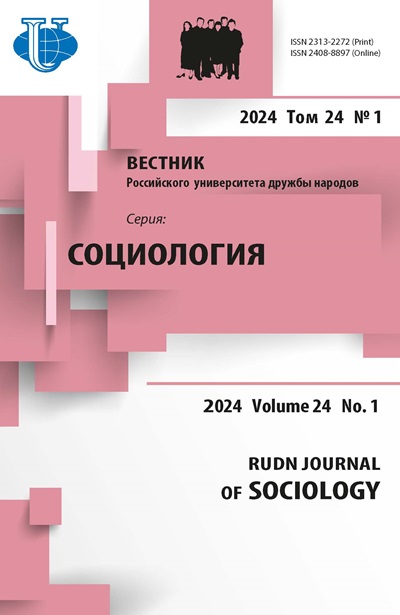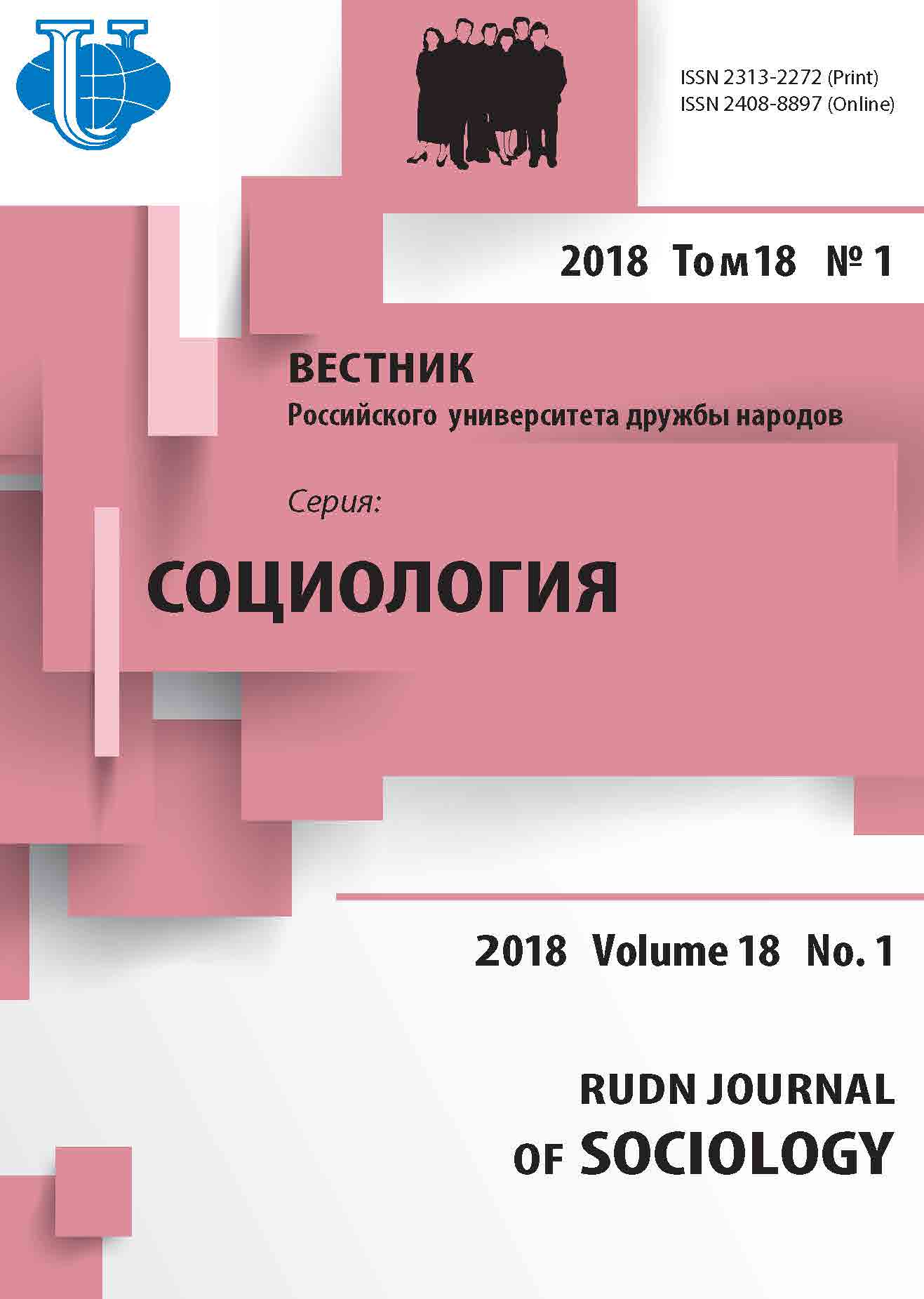KEY FEATTURES OF THE AGRARIAN TRANSFORMATIONS IN THE FORMER GDR
- Authors: Merl S1
-
Affiliations:
- Bielefeld University
- Issue: Vol 18, No 1 (2018)
- Pages: 88-99
- Section: Contemporary society: the urgent issues and prospects for development
- URL: https://journals.rudn.ru/sociology/article/view/17828
- DOI: https://doi.org/10.22363/2313-2272-2018-18-1-88-99
Cite item
Full Text
Abstract
The article considers the agrarian transformations (primarily privatization and structural adaptation to the domestic and international markets) in the former GDR that are often presented as a success story due to the growth in agricultural productivity and competitiveness of new types of agricultural en-terprises. First, the author identifies the main tasks of these transformations: (1) privatization of the “socialist property” and its distribution between (a) those who contributed capital and land to the agricultural enter-prise when it was established, and (b) its employees at the moment of restructuring; (2) adaptation to new market conditions. Both tasks were extremely difficult and challenging for they required large investments in better breeds and machinery, and a significant reduction of agricultural workforce. Second, the author considers the legislative basis for privatization and the real practices of the reorganization of the former agricultural enterprises (proposals for the distribution of the assets, land restitution as prior to compen-sation, the successor large-scale enterprises forced land leasing contracts, manipulations with the balance sheets to obtain hidden reserves necessary for survival by underestimation of the existing assets, etc.). The author believes that the Kohl government did not foresee that privatization would be so complicated, and made many mistakes while striving to keep agricultural production in the new countries, especially to restrain the growth of unemployment. Therefore, the contemporary research of the agricultural economy is very critical of the regulations and frameworks set by the German government that is blamed for being responsible for many serious development constraints (short-term leasing contracts, paying off old debts, the lack of state subsidies for large enterprises, etc.). The final section of the article reveals the meaning of the land property in the agrarian transformations in the GDR. The author relies on the statistical data for more than two decades, monitoring data on the still ongoing transition and his own studies of agri-cultural enterprises in different regions (1992, 1997, 2002 and 2016).
About the authors
S Merl
Bielefeld University
Email: smerl@uni-bielefeld.de
25 University St., 33615, Bielefeld, Germany
References
- Agrarbericht der Bundesregierung 1992-1996. Bonn, 1992-1996.
- Agrarnye preobrazovanija v vostochnoj Germanii [Agrarian Transformations in East Germany]. Moscow: VIAPI; 1997 (In Russ.).
- Balmann A. Land Markets in East Germany: Recent Trends and Policy Challenges. Workshop on February 26, 2016. Halle; 2016.
- Bayer W. (unter Mitarbeit von Thomas Hoffmann) Gutachten: Die Umwandlung der Landwirtschaftlichen Produktionsgenossenschaften im Land Brandenburg. Jena; 2012.
- Der Spiegel. 1996. No. 33.
- Herzfeld Th. Renationalization of EU’s Common Agricultural Policy. Workshop at IAMO, on February 24, 2016. Halle; 2016.
- Gampe W., Heller G. Beispiele der Umstrukturierung von ehemaligen LPGen zu einem Einzelunternehmen, einer Gesellschaft bürgerlichen Rechts und einer eingetragenen Genossenschaft. Fallbeispiele zu Umstrukturierungen von ehemaligen LPGen. Frankfurt am Main; 1992. Pp. 72-111.
- Gravert H., Schmitz M. Die Auswirkungen der staatlichen Biogasförderung auf landwirtschaftliche Pachtpreise in Deutschland. Eine ökonometrische Untersuchung. Die Zukunft der Bioenergie. Frankfurt am Main; 2014. Pp. 7-43.
- Jaster K., Filler G. Umgestaltung der Landwirtschaft in Ostdeutschland (Humboldt-Universität zu Berlin. Wirtschafts- und Sozialwissenschaften an der Landwirtschaftlich-Gärtnerischen Fakultät. Working Paper 68. Berlin; 2003.
- Koch H., Moll A., Thiele H. Die Umstrukturierung einer Groß-LPG zu einer Holding als Besitz- und Verwaltungsgesellschaft mit 15 Betriebsgesellschaften. Fallbeispiele zu Umstrukturierungen von ehemaligen LPGen. Frankfurt am Main; 1992. Pp. 112-144.
- Latacz-Lohmann U., Hennig S., Dehning R. Biogas als Preistreiber am Boden- und Pachtmarkt? Die Zukunft der Bioenergie. Frankfurt am Main; 2014. Pp. 45-75.
- Merl S. Schinke E. (Eds.) Agrarwirtschaft und Agrarpolitik in der ehemaligen DDR im Umbruch. Berlin; 1991.
- Merl S. Problems of German agriculture in transition to the market and policy consequences for the Soviet Union. Bodenstedt A.A., Merl S., Nutrikhin V.A. (Hg.) Social Problems in Rural Areas under Conditions of Change. Contributions to the International Symposium in Vologda, September 1991. Berlin; 1993. Pp. 103-118.
- Rost D. Landwirtschaft im ländlichen Raum - Funktionen, Formen, Konflikte. Zwei vergleichende explorative Fallstudien in Ostdeutschland. Landwirtschaft im ländlichen Raum - Funktionen, Formen, Konflikte. Frankfurt am Main; 1997. Pp. 53-91.
- Rost D., Schmidt A. Entwicklungshemmnisse landwirtschaftlicher Unternehmen in den neuen Bundesländern. Entwicklunghemmnisse landwirtschaftlicher Unternehmen in den neuen Bundesländern. Frankfurt am Main; 1993. Pp. 57-95.
- Schnabel U. Entwicklungshemmnisse landwirtschaftlicher Unternehmen in Form juristischer Personen des Privatrechts in den neuen Bundesländern. Entwicklungshemmnisse landwirtschaftlicher Unternehmen in den neuen Bundesländern. Frankfurt am Main; 1993. Pp. 149-177.
- Thiele H. Politikbedingte Entwicklungshemmnisse landwirtschaftlicher Unternehmen in den neuen Bundesländern. Ent wicklunghemmnisse landwirtschaftlicher Unternehmen in den neuen Bundesländern. Frankfurt am Main; 1993. Pp. 97-147.
- Welschof J., Schmidt D.O., Klaus H. Eine empirische Untersuchung der Entwicklungshemmnisse landwirtschaftlicher Unternehmen in den neuen Bundesländern. Entwicklunghemmnisse landwirtschaftlicher Unternehmen in den neuen Bundesländern. Frankfurt am Main; 1993. Pp. 13-55.
- Wissing P., Rost D. Die Umstrukturierung der Kooperationen Oßmannstedt (Thüringen), Rietnordhausen (Harzvorland) und Dahme (Brandenburg). Fallbeispiele zu Umstrukturierungen von ehemaligen LPGen. Frankfurt am Main; 1992. Pp. 11-36.
- Wolz A. Changes in the Organization of Agricultural Production in East Germany Since Reunification: Major Issues. Workshop at IAMO, 24 February 2016. Halle; 2016.
- Zeddies J. Entwicklungshemmnisse landwirtschaftlicher Unternehmen in den neuen Bundeländern. Entwicklunghemmnisse landwirtschaftlicher Unternehmen in den neuen Bundesländern. Frankfurt am Main; 1993. Pp. 179-226.














